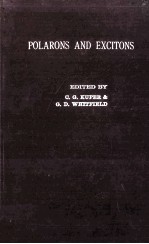图书介绍
Polarons and ExcitonsPDF|Epub|txt|kindle电子书版本网盘下载

- 著
- 出版社: Oliver and Boyd Ltd.
- ISBN:
- 出版时间:1963
- 标注页数:381页
- 文件大小:70MB
- 文件页数:398页
- 主题词:
PDF下载
下载说明
Polarons and ExcitonsPDF格式电子书版下载
下载的文件为RAR压缩包。需要使用解压软件进行解压得到PDF格式图书。建议使用BT下载工具Free Download Manager进行下载,简称FDM(免费,没有广告,支持多平台)。本站资源全部打包为BT种子。所以需要使用专业的BT下载软件进行下载。如BitComet qBittorrent uTorrent等BT下载工具。迅雷目前由于本站不是热门资源。不推荐使用!后期资源热门了。安装了迅雷也可以迅雷进行下载!
(文件页数 要大于 标注页数,上中下等多册电子书除外)
注意:本站所有压缩包均有解压码: 点击下载压缩包解压工具
图书目录
INTRODUCTION TO THE THEORY OF THE POLARON&H.FROHLICH1
1.Historical Introduction1
2.Qualitative Survey3
2.1.The size of the polaron5
2.2.Simple theory of the polaron effective mass7
2.3.Localization10
3.Macroscopic Model11
4.Derivation of the Hamiltonian14
4.1.Example:a classical point charge at rest20
5.Solutions for Weak Coupling22
Appendix:Canonical transformation from coordinate and momentum variables to creation and annihilation operators28
INTERMEDIATE-COUPLING POLARON THEORY&DAVID PINES33
1.Introduction33
2.Canonical Transformations36
2.1.Elimination of the electron coordinate and momentum36
2.2.The"displaced-oscillator"transformation37
3.Properties of the Intermediate-Coupling Solutions40
4.Range of Validity of Intermediate-Coupling Theory42
STRONG-COUPLING THEORY OF THE POLARON&G.R.ALLCOCK45
1.Introduction45
2.The Adiabatic Approximation46
2.1.Diagonalization of the interaction46
2.2.The eigenfunctions of H148
2.3.Minimization of H149
2.4.The Born-Oppenheimer approximation51
3.The Harmonic Approximation53
3.1.The structure of the adiabatic Hamiltonian53
3.2.Introduction of translational coordinates54
3.3.Evaluation of the kinetic energy in terms of the translational coordinates56
3.4.The Hamiltonian in the harmonic approximation61
3.5.Some properties of the harmonic Hamiltonian63
3.6.Pekar's approximate Hamiltonian65
3.7.Introduction of three extra oscillators66
Appendix:Variational derivation of the polaron rest energy and effective mass in the strong-coupling region67
FEYNMAN'S PATH-INTEGRAL METHOD APPLIED TO THE EQUILIBRIUM PROPERTIES OF POLARONS AND RELATED PROBLEMS&T.D.SCHULTZ71
1.Path-Integral Formulation of Quantum Mechanics71
1.1.Introduction71
1.2.Transformation functions and the density matrix74
A.Transformation functions74
B.Density matrix in the canonical ensemble75
1.3.Path-integral formulation of the transformation function76
A.The composition property76
B.Transformation function for infinitesimal times76
C.The path integral77
D.Some remarks77
1.4.Evaluation of path integrals78
A.Free particle,L = 1/2mx279
B.Free harmonic oscillator in one dimension,L = 1/2m(x2-w2x2)79
C.Forced harmonic oscillator in one dimension82
2.Path-Integral Approach to the Polaron,T = 085
2.1.Formulation of the problem in path integrals85
2.2.The Feynman variational principle88
2.3.Ground-state energy and effective mass,Feynman approach90
A.Ground-state energy90
B.Polaron effective mass93
2.4.Polaron model corresponding to the Feynman approximation95
2.5.Perturbation corrections to the Feynman approximation98
3.The Polaron at Finite Temperatures99
3.1.Electron-lattice partition function in path-integral formalism99
3.2.Variational principle and approximate action101
4.Feynman Approximation for other Electron-Lattice Problems104
4.1.Polaron bound to a point defect104
4.2.An exciton interacting with lattice vibrations107
4.3.Bipolarons110
4.4.Polaron in a static magnetic field110
SEMINAR:Polaron Mobility using the Boltzmann Equation111
THE ELECTRICAL TRANSPORT PROPERTIES OF POLARONS&P.M.PLATZMAN123
1.Introduction123
2.Formulation of the Mobility Problem in terms of the Electron Coordinates alone124
3.A Method of Approximation132
4.First Correction Term135
5.Behaviour of the Impedance138
5.1.Zero temperature,v<1;effective ass139
5.2.General expression for dissipation139
5.3.Dissipation at low temperatures141
5.4.Behaviour at high temperatures146
6.Weak-Coupling Limit:The Boltzmann Equation147
7.Suggestions for Improving Accuracy150
ELECTRON,PHONON AND POLARON PROPAGATORS&DAVID PINES155
1.Introduction155
2.The One-Electron Green's Function156
2.1.Spectral representation of the one-electron Green's function159
3.The Phonon Propagator162
4.Electron-Phonon Interactions:Feynman Diagrams163
APPLICATION OF GREEN'S FUNCTION TECHNIQUES TO THE POLARON PROBLEM&R.PUFF and G.D.WHITFIELD171
1.Introduction171
2.Definition and General Properties of G172
3.Equations of Motion175
4.Approximate Solutions for Small and Intermediate Values of α178
4.1.Non-interacting case178
4.2.Perturbation theory179
4.3.Hartree-Fock approximation181
5.An Exactly Soluble Model184
6.Strong Coupling186
7.Many-Electron Green's Functions and the Strong-Coupling Limit186
SEMINARS ON GREEN'S FUNCTION METHODS191
1.Theory of the Propagation of Resonant Radiation in a Gas.&S.DONIACH191
2.Electrical Conductivity in Metals.&J.RANNINGER202
SELF-TRAPPING OF AN ELECTRON BY THE ACOUSTIC MODE OF LATTICE VIBRATION&Y.TOYOZAWA211
1.Introduction and Continuum Model211
1.1.Elastic continuum model213
2.The Tight-Binding Model217
2.1.Discontinuous change in the effective mass217
2.2.The variation of the effective mass with coupling constant220
3.Adiabatic Theory of the Self-Trapped State224
3.1.The results of calculation in the case of a simple cubic lattice228
SEMINARS ON LOCALIZED ("SMALL") POLARONS233
1.Model of Thermally-Activated Polaron Motion.&G.L.SEWELL233
2.Interaction of a Polarizable KC1 Crystal with a Valence-Band Hole.&S.J.NETTEL245
3.Optical Absorption by Small Polarons.&D.M.EAGLES255
THEORY OF EXCITONS-I&R.J.ELLIOTT269
1.Introduction269
1.1.Approximations269
1.2.Formulae for optical properties271
2.Band Theory272
2.1.Band-to-band transitions in semiconductors273
3.Effective-Mass Theory for Excitons275
4.Transitions to Exciton States279
4.1.Direct transitions279
4.2.Indirect transitions282
5.Effect of a Magnetic Field284
5.1.Band states in a magnetic field284
5.2.Band-to-band transitions in a magnetic field285
5.3.Excitons in a magnetic field287
6.Effects of Electron Spin287
7.Exciton Polarization Effects289
8.Some experimental results289
8.1.Germanium289
8.2.Cuprous Oxide290
Appendix292
THEORY OF EXCITONS-II&H.HAKEN295
1.Introduction295
2.Variational Calculation of the Interaction of an Exciton with the Lattice Vibrations at T = 0297
2.1.Symmetry properties of the basic states297
2.2.Properties of the polaron wave functions297
2.3.Exciton variational principle298
2.4.Evaluation of the effective electron-hole potential in the intermediate-coupling region301
3.Treatment of the Exciton as a Many-Body Problem303
3.1.Historical introduction303
3.2.Treatment of the many-body Hamiltonian305
3.3.Multipole expansion of Coulomb interaction308
3.4.Diagonalization of the pair-pair interaction309
3.5.Transition to the effective two-particle Hamiltonian310
3.6.Summary313
3.7.Recent literature313
4.Feynman Methods Applied to the Exciton Problem313
4.1.Characteristics of Feynman's polaron313
4.2.Extension of this method to the exciton314
4.3.Generalization to non-zero temperature315
4.4.On the use of time-ordered operators316
4.5.Disentangling of phonon operators and elimination of phonon coordinates317
4.6.Approximation procedure for calculating the temperature-dependent Green's function318
4.7.Use of the trial Hamiltonian to calculate polaron damping and effective mass320
EXPERIMENTS ON THE POLARON&F.C.BROWN323
1.The Measurement of Carrier Mobility in Polar Crystals323
1.1.Introduction-elementary concepts323
1.2.Survey of polar crystals324
1.3.Drift mobility and Hall mobility326
A.Semiconductors326
B.Insulating photoconductors328
2.Temperature-Dependence of Polaron Mobility335
2.1.Theoretical formulae335
2.2.Experimental results:semiconductors and weakly polar crystals337
2.3.Mobility results-ionic crystals339
A.The alkali halides339
B.The silver halides340
3.Cyclotron Resonance in Silver Bromide345
4.Optical Properties of the Silver Halides347
4.1.Introduction347
4.2.Direct transitions347
4.3.Indirect transitions349
SEMINARS ON EXPERIMENTAL WORK357
1.Polarons in Cyclotron Resonance.&G.ASCARELLI357
2.Excitons in Germanium.&T.P.MCLEAN367
3.The Effects of Perturbations upon the Excitonic Spectrum of Cuprous Oxide.&M.GROSMANN373